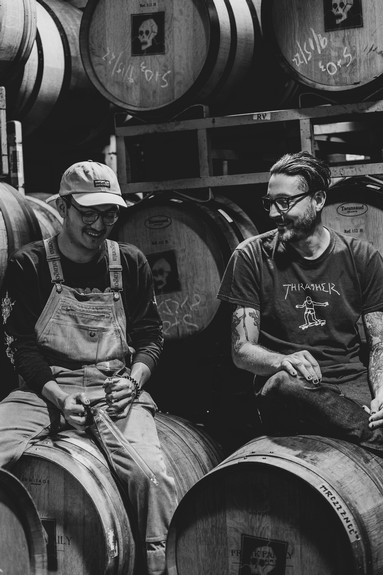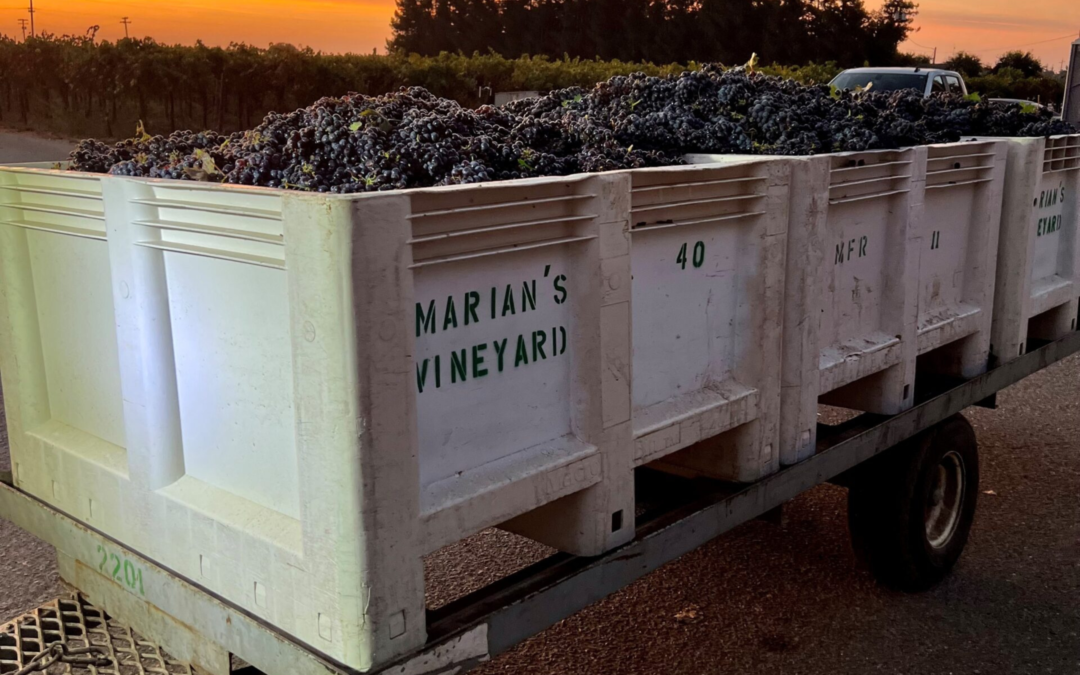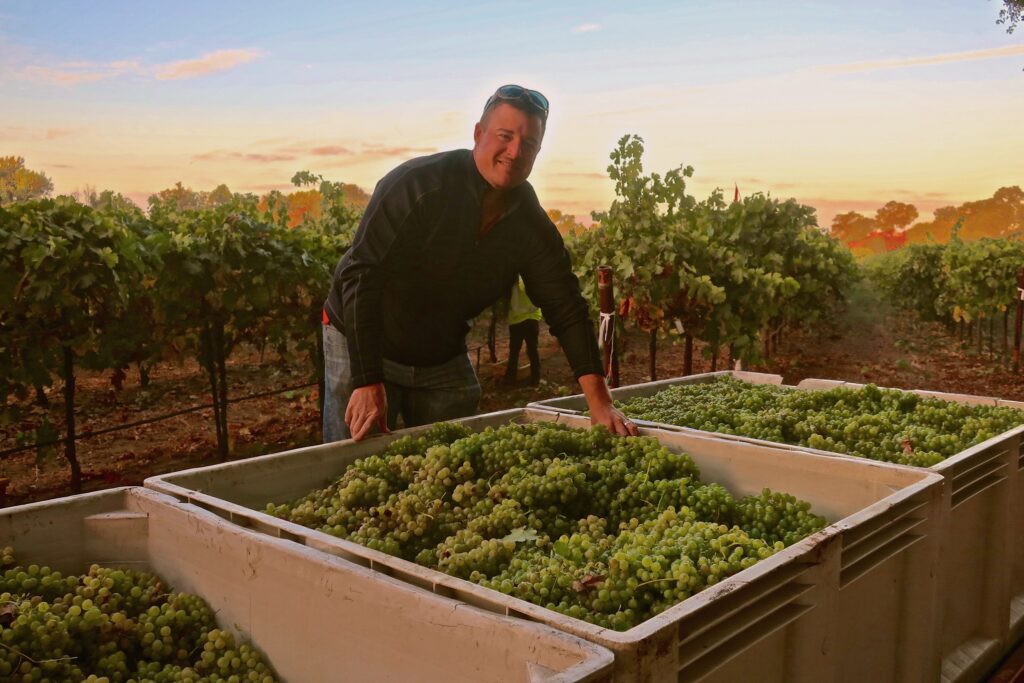MONDAY, DECEMBER 4, 2023. BY STUART SPENCER, LODI WINEGRAPE COMMISSION.
“Indecisions, frustrations, disappointments, and surprises best describe the grape situation.” Those were the thoughts of Jim Kissler, San Joaquin County Viticulture Farm Advisor following the 1974 harvest. He continued, “Some growers had trouble obtaining the minimum sugar requirements of 22 brix,” and “growers without a home for their grapes found it frustrating.” Kissler concluded, “Major concerns among growers are the big increases in the cost of production and the uncertainty of the market in the future.” These thoughts mimic the sentiments of many Lodi growers following the challenging 2023 harvest.
The Good
Despite the challenges and late harvest, winemakers are reporting exceptional quality wines from this year’s crop. Winemaker compliments for the 2023 Lodi vintage include fantastic color, higher acidity, and excellent flavor. And due to the longer growing season, many vineyards achieved ripeness at lower sugar levels resulting in fresher, lower alcohol wines.
Jeremy Trettevik of Jeremy Wine Co. states, “The fruit quality this year was exceptional. With the extended hang time in the vineyard, the grapes came into the winery with very well-developed phenolics coupled with moderated brix and near-perfect acids. Early tastings of this year’s wines show a stunning depth of aromatics and texture. Aside from the early hardships, this has been one of my favorite quality harvests to date.”
The number of vintners sourcing grapes in Lodi continues to grow with artisan brands drawn to Lodi’s diverse varietals, old vines, and quality value relationship. These brands continue to promote Lodi throughout the world, elevating the region’s awareness and reputation. These vintners, including Patrick Cappiello pictured below, are investing in Lodi growers and helping tell the Lodi story.
 Patrick Cappiello with assistant winemaker Jesus Aleman in Monte Rio Cellars. Leigh-Ann Beverley.
Patrick Cappiello with assistant winemaker Jesus Aleman in Monte Rio Cellars. Leigh-Ann Beverley.
Additionally, Michael David Winery deserves special recognition for their response to an oversupplied grape and wine market as we are currently experiencing. They offered their growers partial payments to not deliver contracted grapes while still allowing growers to sell their grapes elsewhere if desired. This effort demonstrates a real commitment to sustainability and a true grower-vintner partnership.
The Bad
The 2023 winegrape market was one of the worst in recent memory, with uncommitted grapes struggling to find a home and contracted grapes struggling to make it into the winery for a variety of reasons. Sluggish to negative wine sales over the past few years, combined with a global oversupply of grapes and wine, led many winegrape buyers to search for ways to reduce inventory and produce less wine in 2023. Unfortunately, this situation left many vineyards (growers) without a buyer at the end of the day. The outlook for wine sales moving forward is mixed with the industry facing many headwinds including competition from other alcoholic beverages, aging wine drinkers, and neo-prohibitionist efforts that could impact future wine sales growth. A combination of demand growth and supply reduction is necessary to bring the market into better balance.
The growing season presented several other challenges for growers as well. Most vineyards and grape varieties were at least two to three weeks behind normal, and in some cases, logistical challenges at wineries extended harvest even later. A relatively cool and humid August and September increased disease pressure and pushed harvest later, exposing vineyards to an increased risk of not getting harvested. In some vineyards, mostly Zinfandel, multiple fruit thinning passes by hand was required to remove rot. A statewide multi-crop “super bloom” of fruit flies this year only exacerbated the rot pressure.
The Ugly
Over the past 20 years, the California wine industry has embraced sustainability. Much progress has been made, and our industry is recognized as an early adopter of sustainability. One core tenet of sustainability, as it is defined in the United States, is taking care of your community. Most wine companies have adopted corporate responsibility statements that address the importance of investing and supporting the communities which they operate within. However, especially felt this vintage, there exists a widening gap between the statements of some wine companies and the reality facing the average independent grower.
Lodi growers had more grapes rejected, for more reasons, during the 2023 vintage than most can remember. At a recent Lodi Winegrape Commission Board meeting the rejection reasons were shared. These included: MOG (matter other than grapes), rot, mildew, not meeting minimum brix requirements, volatile acidity, quality, and something new to most of us called “rose taint”. These rejection reasons sound reasonable and fair until you learn the rest of the story, which is that there are often no third-party testing standards/protocols or metrics for many of these rejection reasons (with the exception of MOG and sometimes brix), nor are there metrics to make it possible for a grower to understand what is expected of them. Compounding the problem for the grower is the fact that to argue with a winery over a grape rejection is in essence biting the hand that feeds you.
In some cases, rejection decisions were arbitrary. Wineries rejected fields for too much rot after the grower thinned out the rot by hand three times at the wineries request. Loads were rejected for coming up 0.1-degree brix short of the minimum sugar requirement, while the rest of the field met or exceeded that minimum and was taken. Some growers whose contracts had expired were strung along all season only to be offered a low-ball price come harvest time. All too often, the growers are understandably afraid to push back for fear of it impacting future grape sales.
In Conclusion
True grower-vintner partnerships that recognize the potential quality of the grapes and wine, compensate growers fairly, and strive together to elevate the region and drive profitability for both grower and vintner are what the Lodi region needs more of. Sustainability does not happen without profitability. It is more than just words in a press release, or a seal on a wine bottle; it is what happens when no one is looking, and it is imperative for the health of our industry that these issues are addressed.
Craig Ledbetter, Vino Farms during the 2023 harvest. Randy Caparoso.
Have something interesting to say? Consider writing a guest blog article!
To subscribe to the Coffee Shop Blog, send an email to stephanie@lodiwine.com with the subject “blog subscribe.”
To join the Lodi Growers email list, send an email to stephanie@lodiwine.com with the subject “grower email subscribe.”
To receive Lodi Grower news and event promotions by mail, send your contact information to stephanie@lodiwine.com or call 209.367.4727.
For more information on the wines of Lodi, visit the Lodi Winegrape Commission’s consumer website, lodiwine.com.
For more information on the LODI RULES Sustainable Winegrowing Program, visit lodigrowers.com/standards or lodirules.org.



